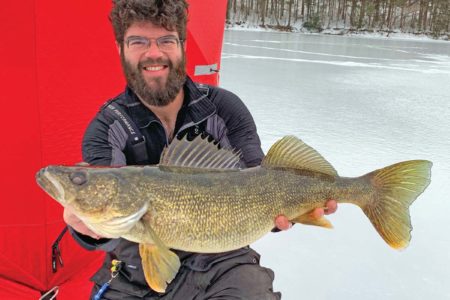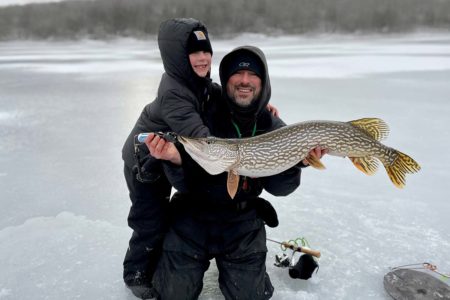Play the audio file to listen to this feature.
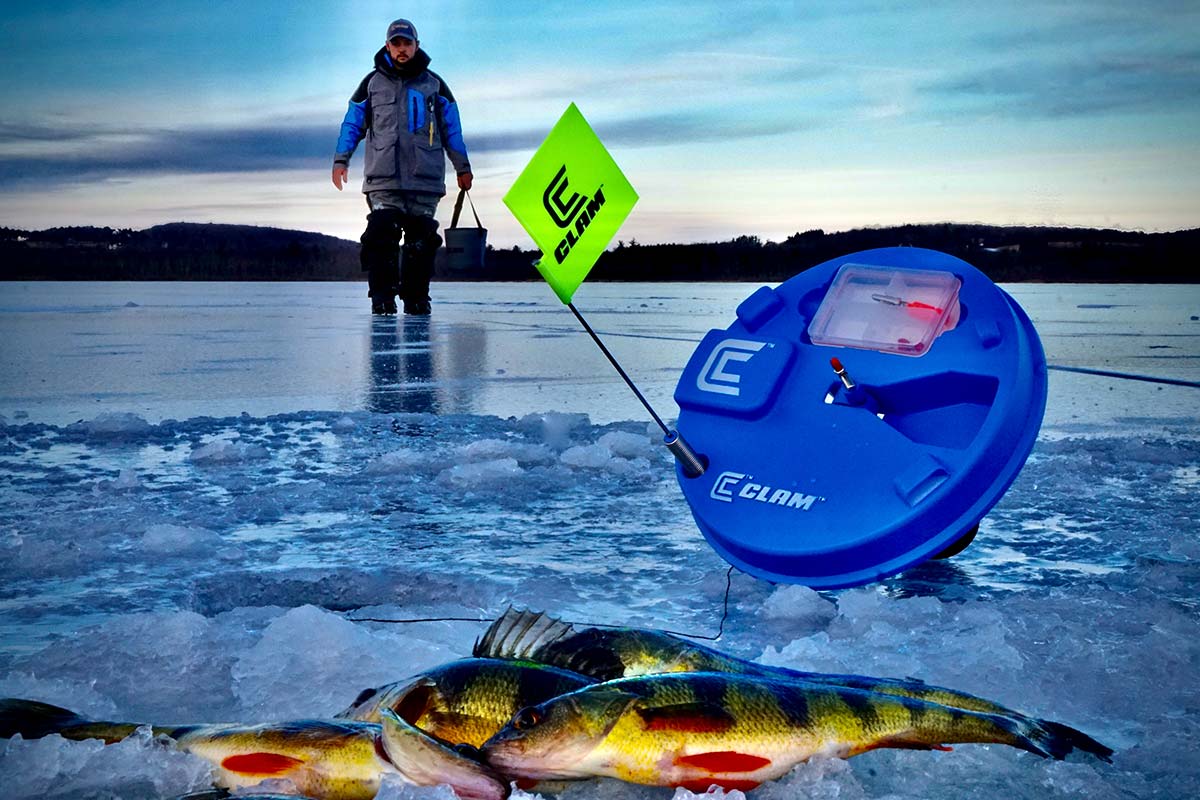
An introductory course into the fun and exciting world of ice fishing.
The long days of summer have come to an end and the cold of winter has arrived. Many anglers have already put their fishing gear away and have begun to start thinking ahead to the spring. For others, though, the best fishing of the year has yet to begin: ice season. Ice fishing can be one of the most fun angling experiences of the year. To some, ice fishing is a foreign language but it is easy to learn and can be a great way to spend time outdoors in the often long winter months.
Ice fishing can be a lot of fun but it needs to be approached with caution. Ice anglers all over the world tend to use four inches of new, clear ice as a baseline as to when it is safe to venture out onto the ice by foot. As you walk onto the ice, it is very important to stop periodically and check the thickness of the ice since it can change substantially over a short distance. This is most commonly done with the use of a spud which is a long metal rod with a chisel on the end. The spud is thrust into the ice repeatedly until breaking through to determine thickness. There are many factors that affect ice thickness such as snow cover, currents running under the ice, rain, weather, and even factors such as waterfowl activity.
It is generally safe for vehicles such as ATVs and snowmobiles to venture out onto the ice when six inches of solid, clear ice has formed. Once 10-plus inches has formed, it is now generally safe for cars and small trucks to navigate on the ice. If you decide to operate a vehicle on the ice, it is important to drive slowly and to be aware of your surroundings as well as the ice beneath you.
Once you have determined that you have “safe ice”, you can now gear up for a day of fishing. Ice fishing can be broken up into two main strategies: tip-up fishing and jigging. Jigging is performed with a rod and reel while tip-up fishing uses baited tilts to entice a bite. Both methods can yield success and often a combination of the two is your best option.
Tip-Ups Or Traps
Tip-up fishing is done by setting a trap or, “tip-up” up in a hole and baiting the rig for success. Tip-ups are most commonly made of wood or plastic with a spool on the end and a flag at the other. When a fish takes the bait, the spool turns and triggers the flag to go up, thereby signaling the angler of a bite; this is when the fun begins! Anglers all over frozen lakes can be heard yelling, “Flag!” This triggers a rush to the hole to see what has taken the bait. The angler pulls the tip-up out of the hole and then, hand-over-hand, fights the fish to the opening. Tip-ups can be purchased at most bait shops and sporting goods stores. The wood variety are generally a bit pricier but tend to last longer and are sturdier than the plastic kind. The line that goes on the backing of a tip up is usually a thick nylon or vinyl that doesn’t knot up easily and is much simpler to untangle than traditional fishing line. It also doesn’t have any memory so it doesn’t spin off like a slinky from sitting on the spool. At the terminal end of the backing a leader is tied, usually monofilament or fluorocarbon of various lengths and strengths depending on the species that is being targeted.
When baiting a tip-up, shiners are by far the most readily available and popular bait to use. A medium shiner will catch just about any fish you desire through the ice. That being said, depending on the species you are targeting, there are many other options including night crawlers, waxworms, or spikes. Others who target larger species may choose to use large live or dead bait such as pond shiners or fallfish.
The depth that you set your tip-up changes depending on the conditions or the fish you are targeting. In general, most anglers set their traps just off the bottom. A simple weight called a “sounder” is used to identify the bottom. A button, bobber, or similar “marker” is then used on the line as an indicator of how deep to set your line each time a flag goes off. This eliminates the need to “sound” the hole every time you catch a fish or check your bait. That depth indicator can also be useful in knowing how much line a fish has taken, especially when the fish is not landed or drops the bait when you set the hook.
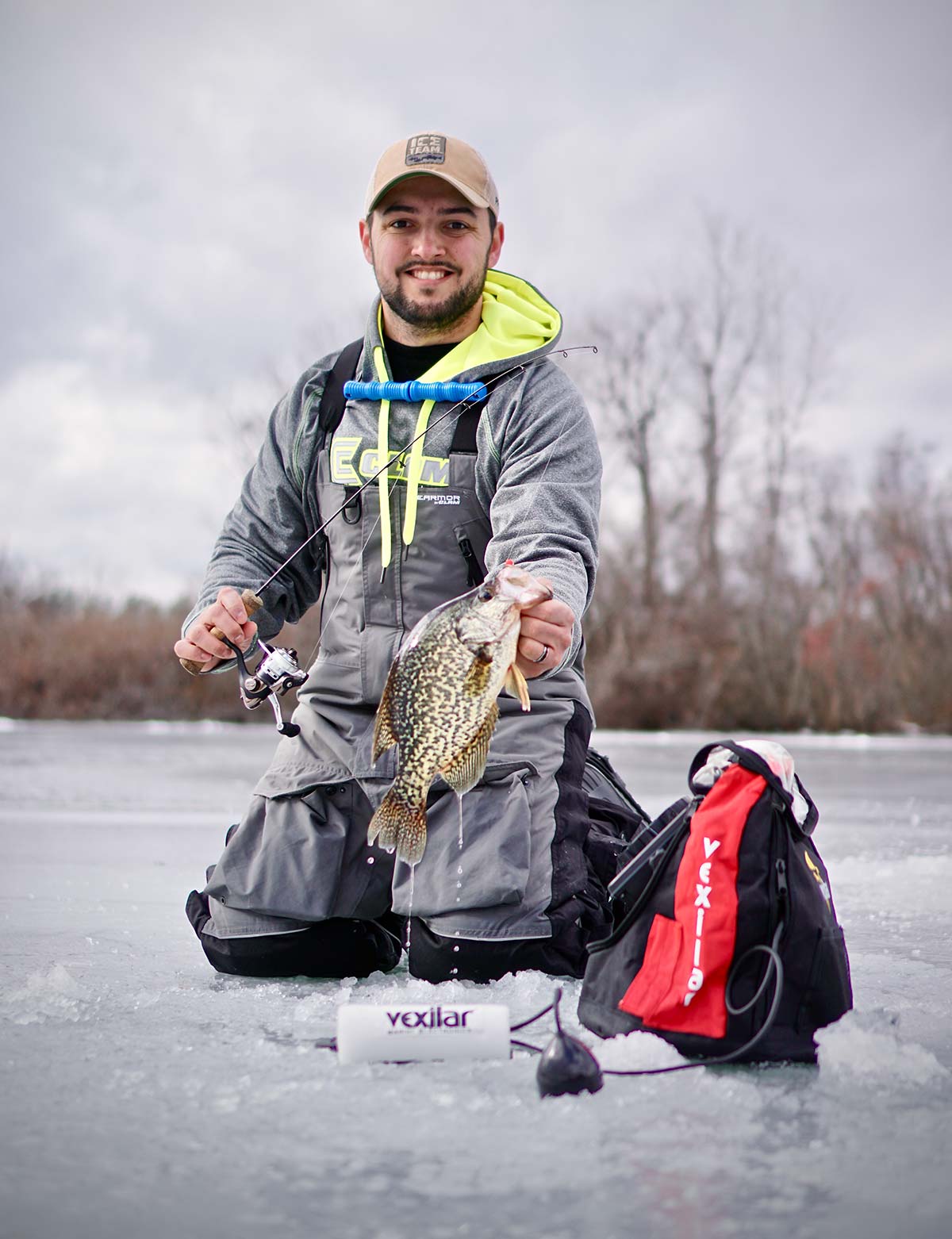
Jigging
Jig fishing is much like vertical jigging in open water except that the rods are much shorter than open-water rods although longer rods up to 40 inches or more are becoming popular for certain applications. When used for panfish—a popular target for many ice anglers—the rods are very sensitive and can detect even the slightest tap from a bluegill. Not all jig fishing is about relatively small panfish, though. Anglers also target larger fish such as lake trout, bass, walleye and other predatory fish while jigging. These rods can get stout which is necessary when battling larger fish.
There is no one rod that is perfect for all applications. Much like open water, every rod has its strengths and weaknesses. When I am actively jig fishing, moving around and jumping from hole to hole, I fish a longer rod which allows me to remain standing. I can then stay mobile and fish a hole for little and walk to the next hole if I don’t find success. If I am sitting down and fishing, I use a shorter rod that allows to me to be right on top of the hole and gives me a better feel of what is going on below the ice.
The tip of an ice rod can be fitted with a spring bobber. These spring bobbers give anglers a visual point of reference for detecting subtle and delicate bites. Selecting a rod depends on many factors but whenever giving an angler advice on buying a rod, I always tell them to pick it up and choose a rod that is comfortable for them. I like a rod that feels well balanced in my hand; I look at the various reel seats and chose one that feels best for the way that I grip the rod. I check the action on the rod and inspect the sensitivity as well as the backbone and try to make the best choice by balancing these variable. That is the ultimate factor; a rod may work great for one angler and not for another, so it is important to choose what works best for you and your fishing style.
Ice-Specific Line
Ice fishing requires specific ice fishing gear and fishing line is no exception. While you can use regular monofilament, fluorocarbon, or braid, ice-specific lines will almost always out perform these generic fishing lines. Ice line is designed specifically for the elements you encounter on the ice. Ice line is abrasion-resistant to help fight off weak points from rubbing against the edge of a hole. It also features lower stretch for stronger hooksets and higher sensitivity. Because of the small spool sizes, low memory is also very important so the line has less coil and offers a straighter, more natural presentation. Ice monofilament line is a great overall choice. It has less memory than fluorocarbon which prevents it from coiling up when fishing those small jigs. Monofilament has a bit of stretch which does help absorb the head shaking of some of the more aggressive fish.
Fluorocarbon has less visibility than monofilament which makes it a great choice for those picky fish that need a finesse approach. Fluorocarbon also sinks faster than monofilament which allows you to get back down to the strike zone much quicker. That being said it does have some downfalls such as the memory of the line. Fluorocarbon needs to be changed often. The longer it stays on your spool the more it will coil up and ultimately make your presentation spin in the water, making it less realistic and greatly lowering your catch rate.
Braided line may seem like the easy answer to the ice fishing line question as it has little to no stretch or memory and gives you great feel for your jig, the bottom, and even the slightest taps can be felt with braid. The only problem is that braid absorbs water, and when fishing out in the cold the line will then freeze up. If you are fishing inside a heated shelter or on a warmer day you won’t have to worry about this. Each type of line has its strengths and weaknesses; ultimately try each out and choose the line that is right for you.
There are countless different options for ice fishing lures such as small jigs, spoons, and micro crankbaits for vertical jigging. When selecting a lure for jigging, the material used is of great importance. The advent of tungsten jigs has been a game-changer in the ice fishing world. Tungsten is much heavier than lead allowing companies to use very small jigs but have them be heavy enough to get through the water column quickly and to the strike zone. Tungsten jigs give you great feel for your presentation and a finicky panfish bite. Jigs are often tipped with a type of live bait such as a wax worm, spike, or mousie. In recent years, soft plastics have become very popular with ice anglers. These plastics are much more durable than live bait and can often catch multiple fish without being changed. When your hands are cold or you can’t get a handle on the small live bait with your gloves, soft plastics provide an excellent alternative with similar results.
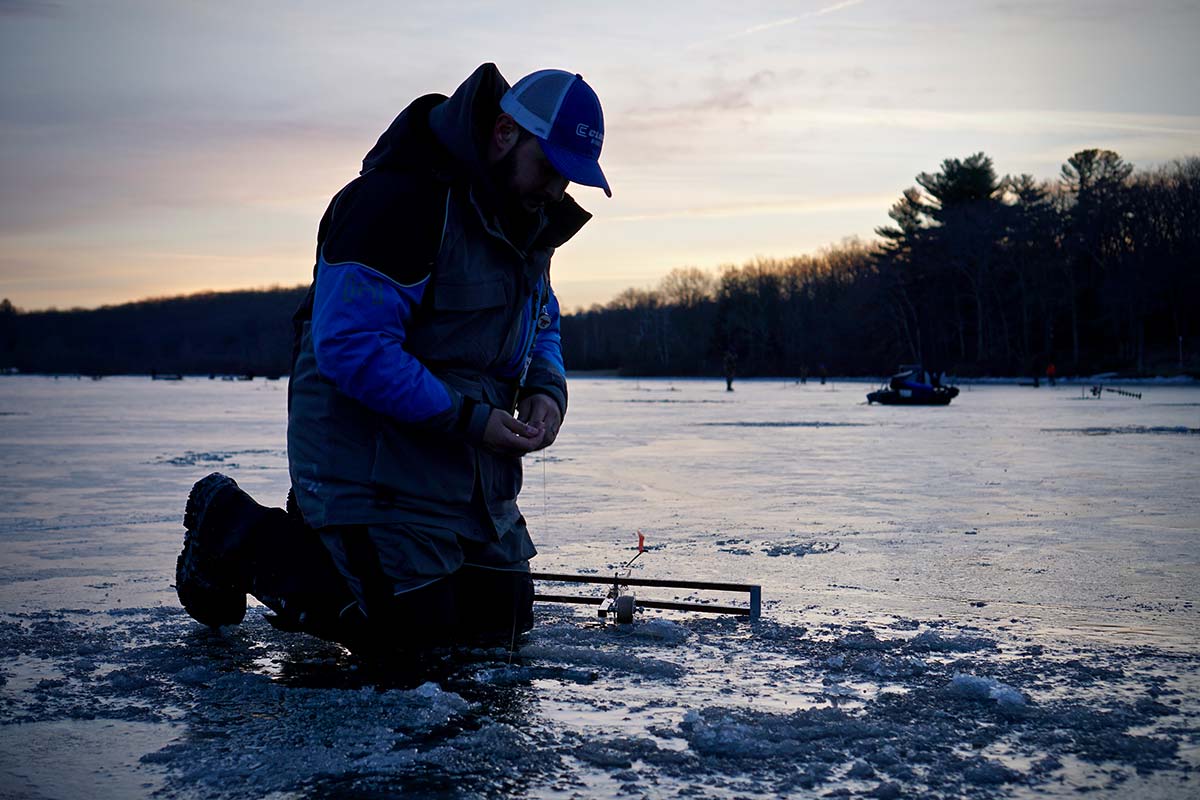
Making Holes
A question many new ice fishing anglers ask is, “What size hole do I need?” There is no right or wrong answer to this question but often the answer is more dependent on your style of fishing and your target species. In most applications when jigging for panfish, a 6-inch hole is sufficient. As you start getting into some larger gamefish such as walleye and pike, an 8- or even 10-inch hole is the standard. Larger holes require much more force to cut which is also something that you should take into consideration when deciding your hole size. If you will be using a hand auger, a smaller hole is much easier to cut. If you use a gas auger then it becomes less of an issue. Gas augers can be heavy, but when using a snow machine or truck to get around on the ice, you worry less about the weight of your equipment.
Electric augers have become more and more popular over the years with many ice anglers. These augers are much lighter than gas augers which makes them easier to drag in your sled, and there is no need to worry about gas or engine troubles with an electric auger. The only thing that is concerning is the battery life. Most anglers carry a spare battery when fishing for long periods of time or cutting many holes. It is important to keep those spare batteries warm in the cold conditions as this will quickly drain the charge of even the best batteries. Just like cutting by hand, the larger the diameter of the hole, the more strain there is on the battery to cut it. A cordless drill-powered auger is the auger of choice for me. My cordless drill gets used all year long which helps me justify the price of the purchase as it is not just something that is used in the winter. My cordless drill-powered auger is super light and durable; as someone who walks on the ice and doesn’t use a snowmobile or ATV this is the best option for me.
“Seeing” What’s Below & Staying Warm
Electronics have come a long way in all aspects of fishing, and this carries over into the ice fishing world. The most popular and widely-used electronics are called “flashers.” A flasher display is a round dial that shows an angler the entire water column below. The display then shows the angler’s fishing lure as well as fish, structure, and weeds below the ice in the form of colored bars or dashes. A flasher is useful because it gives you real-time data and reaction to your jigging motion. There is little to no delay in the information that the flasher is giving you which allows you to see a fish’s reaction to your jigging cadence. Unlike other types of sonar, a flasher has a very detailed and exact display to show you detailed target separation. This allows you to watch the target get closer and closer to your jig and almost simultaneously as the target reaches your jig on the screen, you feel the fish bite.
A big part of ice fishing is staying warm and comfortable as this allows you to spend more time on the ice and make it a more enjoyable experience. Proper layering is very important. There are many days on the ice that start off cold and then slowly warm up. Proper layering allows you to be ready for any situation. Ice fishing suits are now available that not only keep you warm and comfortable, but are actually buoyant. In the event that an accident happens and you fall in, this feature could easily save your life.
Ice fishing shelters help anglers get out of the elements and spend more fishing. Shelters come in two main styles: pop-up hub style shelter and the flip-over shelter. A hub shelter is a tent-style shelter that unfolds and can be set up anywhere on the ice. These shelters can be very large and accommodate a large group of anglers on the ice as well as their gear. These are great for families or groups of friends who want to stay warm and out of the elements. One downside to this style of shelter is that it limits your mobility on the ice and confines you to a general area to fish. The other style is the flip-over shelter. This style of shelter is built onto a sled allowing you to stay mobile on the ice and set up/take down quickly and easily to remain on the go. These shelters are great for single anglers or small groups but are often too small for large parties on the ice.
For many serious anglers buying fishing gear becomes a never-ending journey and ice fishing is no different. Ice fishing can start out very basic, but as you spend more and more time on the ice, the stronger the addiction becomes! A few tip-ups turn into a dozen, a map of the lake turns into a flasher, and your kid’s snow sled turns into a state-of-the-art flip-over ice shelter! Ice fishing continues to grow in popularity every year and after just a few trips on the ice, I would be willing to bet you wouldn’t think that winter is all that bad anymore! So, get out there, be safe, and have a blast on the ice!

